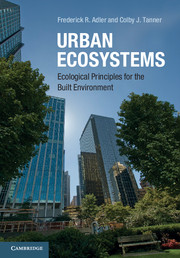2 - Urban accounting: metabolism, energy, and the ecological footprint
Published online by Cambridge University Press: 05 May 2013
Summary
Cities play an increasingly important role in society, with over half of the population now living in urban areas for the first time in history. These increasingly large and demanding concentrations of people, as well as their associated artifacts, raise a whole series of questions about the effects of humans on the environment.
How do urban areas survive, with their dense populations, high demand for resources, and large outputs of wastes?
How can the ecological effects of cities be quantified?
How do those effects depend on the properties of the surrounding region?
Can the methods used to describe and quantify human effects be applied to other social organisms and ecosystem engineers?
This chapter introduces four approaches to quantifying urban resource use and its environmental consequences.
• The urban metabolism tracks the inputs and outputs of a city as if it were as ingle enormous organism. Just as a bird eats, drinks, and collects materials for its nest, cities receive inputs of food, water, materials, and energy. That same bird excretes wastes and sometimes succeeds in raising offspring. Cities too output a variety of waste products, and export manufactured, cultural, and biological products.
• The urban energy budget focuses on a single currency, energy, as the driver of urban life. Every aspect of the urban metabolism, whether it be the import of food and materials, construction of housing, or treatment of wastes, requires energy. How and where that energy is used and collected tells much about how a city functions and survives.
[...]
- Type
- Chapter
- Information
- Urban EcosystemsEcological Principles for the Built Environment, pp. 39 - 73Publisher: Cambridge University PressPrint publication year: 2013



